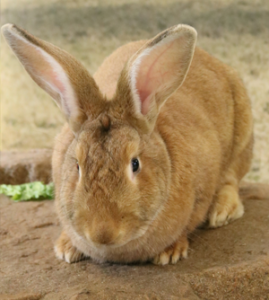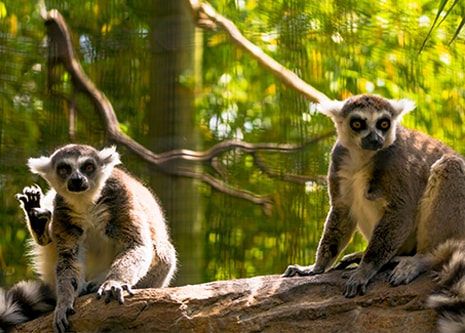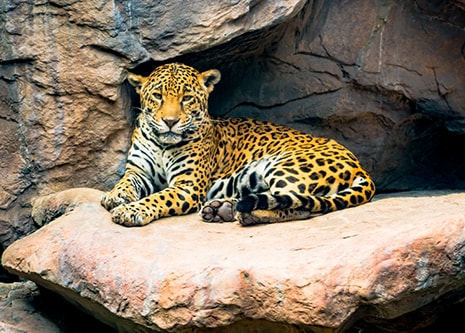
- VisitSupport Happy HollowDONATE TODAYExploreSupport Happy HollowDONATE TODAYLearnSupport Happy HollowDONATE TODAYSupport
-
Today's Hours: 10:00 am to 5:00 pm
Education AmbassadorsDomestic rabbit

Scientific name: Oryctolagus cuniculus
Family: Leporidae
Order: Lagomorpha
Class: Mammalia
Range: Originally Spain and France; Domesticated worldwide
Habitat: Urban
Lifespan: 8 to 10 years in captivity; less in the wildWhat do they look like?
Most domestic rabbits have been bred and domesticated from wild European rabbits. Wild rabbits are generally 13 to 18 inches long and are usually brownish-gray in color. Domesticated rabbits have been bred for their skins, fur, meat, and as pets. The American Rabbit Breeders’ Association recognizes over 40 distinct breeds, many of which have multiple coat colors. They range in size from Netherland Dwarfs, which weigh around 2 pounds, to Flemish Giants, which weigh upwards of 15 pounds, and vary in terms of color, fur softness and ear position.How do they behave?
Wild rabbits live in a warren (a series of tunnels and burrows). They are very social, living in medium to large sized groups with complex hierarchies. Rabbits are crepuscular (most active at dawn and dusk) during which time they will travel short distances from their warren to graze. Rabbits communicate primarily by thumping their large hind legs to alert other rabbits that danger is near, but may use vocalizations as an additional warning signal.What do they eat?
Rabbits are herbivorous (they graze primarily on grasses). In the winter when grass is scarce, they may eat twigs, strip bark from trees, and forage for other plant matter. Rabbits’ digestive systems are evolved to process large amounts of grass with high fiber content. The fiber is fermented by bacteria in the bowel, producing droppings called caecotrophs which are expelled. Caecotrophs are then eaten and digested a second time to further extract essential nutrients. At Happy Hollow, rabbits eat hay, rabbit pellets and leafy vegetables.How are they born?
Rabbit kits are born blind, deaf and hairless, in a chamber of the warren lined with their mother’s fur, which she plucks from her chest and belly. Their litters are usually five to six kits, but may be up to 10. Many wild rabbits breed twice a year, allowing rabbit populations to grow very quickly. Rabbits also mature early, reaching sexual maturity at four to six months of age.Conservation
Domestic rabbits have not been evaluated by the International Union for Conservation of Nature because they were bred by people. However, North America is home to a species of wild rabbit, called the pygmy rabbit (Brachylagus idahoensis), which is the smallest rabbit in North America. Currently populations in the state of Washington are listed as Endangered, due to habitat loss. Organizations such as the Washington Department of Fish and Wildlife are working to protect pygmy rabbit habitat and increase their numbers through captive breeding programs. If you would like to learn more about the North American pygmy rabbit, please visit http://www.iucnredlist.org/details/2963/0If you are interested in a domestic rabbit as a pet, remember to do your research! Rabbits require a lot of their owners. We encourage you to visit your local humane society where you will find people who can help you make the proper pet choice.

Zoo on the Hill
Located across from the Keep-Around Carousel is the Zoo on the Hill. Learn about wildlife up close during daily meet-and-greets, leap like a lemur on the playground, brush and feed the goats,, or take a peek inside Doc’s Critter Care building and the Ranch House. Double-H Ranch features a combination of animal exhibits, including giant anteaters and red ruffed lemurs, as well chickens and domesticated animals that are docile enough to touch.
See Animals
Zoo in the Hollow
Follow the crooked bamboo pathway down into the hollow and visit with some of the most amazing animals in the world. Where else in San José can you get up close to a stunning jaguar, lemur, meerkat or American alligator? Happy Hollow is dedicated to helping save species and preserve wildlife for future generations by participating in Species Survival Plan programs through the Association of Zoos and Aquariums.
See AnimalsVisit Us Today
Plan an unforgettable experience at San Jose’s family-friendly park and zoo.
more info